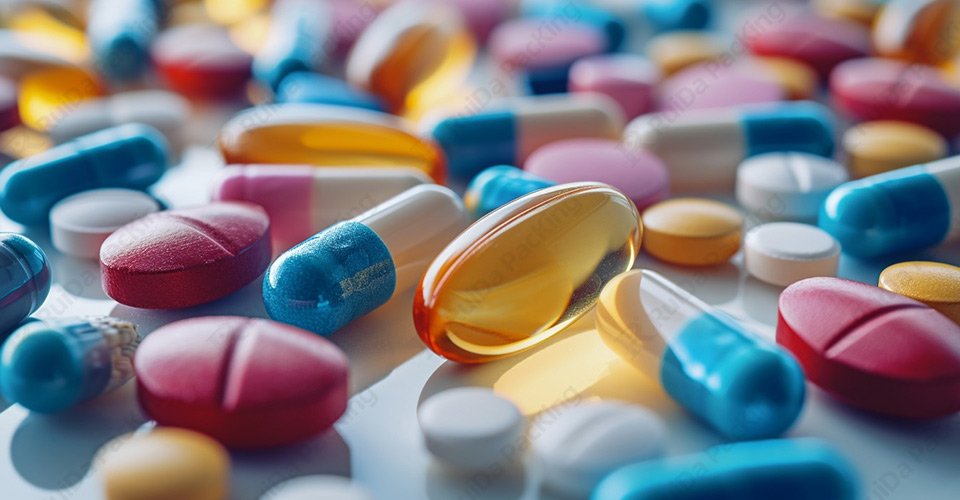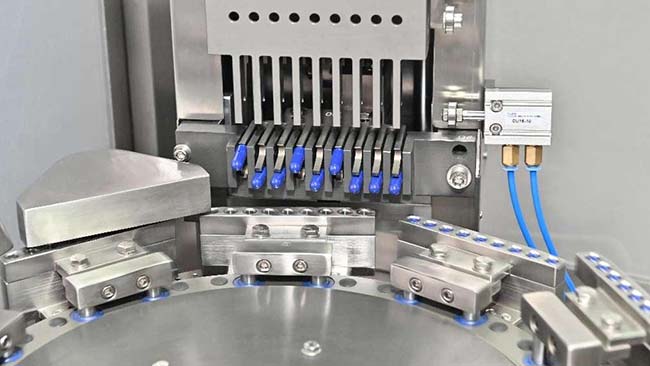당신은 주로 콜라겐에서 추출한 천연 단백질 물질을 사용하고 있습니다. 제약용 젤라틴 소 또는 돼지에서 추출한 특수 가공 콜라겐을 사용합니다. 엄격한 제약 요건을 충족하기 위해 엄격한 정제 및 표준화 과정을 거칩니다.
일반적으로 구성에는 다음이 포함됩니다.
– A형 젤라틴(산처리) 또는 B형 젤라틴(알칼리처리)
– 정제수
– 방부제(필요한 경우)
– 착색제(필요한 경우)

젤라틴 캡슐의 종류
제약 분야에서는 세 가지 주요 유형의 젤라틴 캡슐을 접하게 됩니다.
이 2단 캡슐은 충전 작업의 유연성을 제공하며 분말, 과립 및 소형 펠릿에 적합합니다. 000(최대)에서 5(최소)까지 다양한 크기로 제공되어 다양한 용량 옵션을 제공합니다.
- 연질 젤라틴 캡슐
액체, 오일 또는 현탁액을 다룰 때, 이 일체형 밀봉 캡슐은 탁월한 밀폐성과 안정성을 제공합니다. 고객의 특정 요구에 맞춰 다양한 모양과 크기로 제작 가능합니다.
- 변형 방출 캡슐
이러한 특수 캡슐을 사용하면 장용 코팅이나 변형된 껍질 구성을 포함한 다양한 메커니즘을 통해 활성 성분의 방출 프로필을 제어할 수 있습니다.

제조 공정
원자재
캡슐 제조에서 성공하려면 올바른 재료를 선택하는 것부터 시작해야 합니다.
품질 요구 사항:
– 꽃 강도: 150-280그램
– 점도: 2.5-6.0 밀리포이즈
– 수분 함량: 9-16%
– 회분 함량: <2%
– 중금속 : <10ppm
추가로 필요할 수 있는 재료는 다음과 같습니다.
– 가소제(글리세린, 소르비톨)
– 방부제(이산화황, 메틸파라벤)
– 착색제(승인된 식품 염색제)
– 불투명도 조절제(이산화티타늄)
생산 방법
하드 캡슐 생산
일반적으로 제조 공정에는 다음이 포함됩니다.
- 젤라틴 용액 준비
– 정밀한 온도 조절(60-70°C)
– 공기가 섞이지 않도록 조심스럽게 혼합하세요
– 정확한 농도 조절
- 디핑 공정
– 온도 조절 핀 디핑
– 제어된 체류 시간
– 균일한 필름 형성
- 건조 및 절단
– 통제된 환경 조건
– 정밀한 절단 작업
– 사이즈 확인
연질 캡슐 생산
회전 다이 공정에는 다음이 포함됩니다.
- 젤라틴 리본 형성
- 충전재 캡슐화
- 밀봉 및 형상 형성
- 건조 및 컨디셔닝

주요 속성 및 특성
물리적 특성
다음과 같은 중요한 매개변수를 모니터링해야 합니다.
- 껍질 두께
– 경질 캡슐: 0.095-0.115mm
– 연질 캡슐: 0.110-0.150mm
- 용해 특성
– 일반적인 용해 시간: 15-30분
– pH 의존적 행동
– 온도 감도
- 기계적 특성
– 인장 강도
– 탄력성
– 충격 저항성
화학적 특성
이러한 속성을 이해하면 제품 안정성을 유지하는 데 도움이 됩니다.
- pH 안정성
– 최적 범위: 2.5-7.5
– 버퍼 용량
– 산/염기 상호작용 전위
- 가교 방지
– 온도 조절
– 습도 관리
– 부형제 호환성
응용 프로그램 및 사용
제약 응용 분야
젤라틴 캡슐은 다음과 같은 용도로 활용할 수 있습니다.
- 처방약
– 즉시 방출 제형
– 변형된 방출 시스템
– 복합 제품
- 일반 의약품
– 비타민과 미네랄
– 진통제
– 감기 및 독감 약
건강 보조 식품 응용 프로그램
보충제 옵션은 다음과 같습니다.
- 비타민 제형
– 단일 비타민
– 종합 비타민제
– 미네랄 조합
- 특수 제품
– 허브 추출물
– 에센셜 오일
– 효소 제제
보관 및 취급
보관 요구 사항
최적의 안정성을 위해 다음 조건을 유지하세요.
온도:
– 이상적인 범위: 15-25°C
– 최대 변동: ±3°C
습기:
– 상대 습도: 35-65%
– 모니터링 요구 사항
– 습도 조절 시스템
취급 지침
다음의 모범 사례를 따르세요.
- 환경 제어
– 클린룸 조건
– 공기 여과
– 온도 모니터링
- 인력 요구 사항
– 적절한 훈련
– 보호 장비
– 문서화 절차
품질 관리 및 테스트
품질 매개변수
테스트 프로그램에는 다음이 포함되어야 합니다.
- 신체 검사
– 차원 분석
– 체중 변화
– 분해 시간
– 해산 프로필
- 화학 분석
– 수분 함량
– 중금속
– 잔류 용매
– 콘텐츠 균일성
규정 준수
다음 사항을 준수하십시오.
- FDA 요구 사항
– GMP 가이드라인
– 문서 요구 사항
– 검증 프로토콜
- 국제 표준
– 유럽 약전 사양
– USP 요구 사항
– JP 표준
장점과 한계
이익
다음과 같은 이점을 얻을 수 있습니다.
- 향상된 생체이용률
– 빠른 용해
– 일관된 흡수력
– 효능 향상
- 제조 효율성
– 높은 생산 속도
– 비용 효율성
– 공정 신뢰성
제한 사항
다음과 같은 과제를 고려해 보세요.
- 환경 민감성
– 온도 효과
– 습도 영향
– 보관 요구 사항
- 재료 제한
– 채식주의 제한
– 종교적 고려 사항
– 비용 요소
일반적인 문제 해결
제조 문제
다음과 같은 일반적인 문제를 해결하세요.
- 껍질 형성
– 두께 변화
– 취성
– 부드러운 부분
- 밀봉 문제
– 불완전한 폐쇄
- 누출
– 변형
보관 및 안정성 문제
다음을 모니터링합니다.
- 신체적 변화
– 취성
– 연화
– 변색
- 화학적 분해
– 가교
– 콘텐츠 저하
– 해산 변경 사항
시장 동향 및 미래 발전
현재 시장 동향
다음 사항을 주의하세요.
- 소비자 선호도
– 천연 성분
– 클린 라벨 요구
– 지속 가능성에 대한 우려
- 산업 발전
– 자동화가 발전하다
– 품질 개선
– 비용 최적화
혁신과 개발
다음과 같은 발전을 주목하세요.
- 새로운 기술
– 스마트 캡슐 시스템
– 새로운 코팅 방법
– 첨단 제조
- 지속 가능한 관행
– 바이오 기반 소재
– 에너지 소비 감소
– 폐기물 최소화
모범 사례
최적의 결과를 얻으려면 다음 지침을 따르세요.
- 품질 유지 관리
– 정기 테스트
– 환경 모니터링
– 문서 관리
- 프로세스 최적화
– 매개변수 제어
– 효율성 향상
– 비용 관리
안전 고려 사항
유지하다:
- 물질 안전
– 공급업체 자격
– 테스트 프로토콜
– 오염 방지
- 공정 안전
– 장비 검증
– 인력 교육
– 비상 절차
결론
젤라틴 캡슐의 성공은 생산 및 사용의 모든 측면을 이해하고 관리하는 데 달려 있습니다. 이 종합 가이드는 이러한 다재다능한 약물 전달 시스템을 효과적으로 사용하는 데 필요한 필수 지식을 제공합니다. 최적의 결과를 얻으려면 최신 규정을 준수하고 엄격한 품질 관리를 유지해야 합니다.
더 구체적인 정보나 기술 지원이 필요한 경우, 특정 용도에 대한 자세한 지침을 제공할 수 있는 캡슐 제조업체나 제약 전문가에게 문의하세요.


